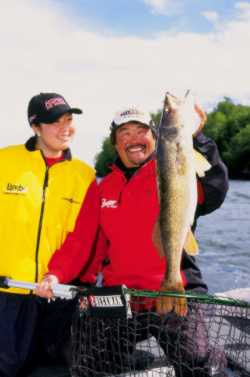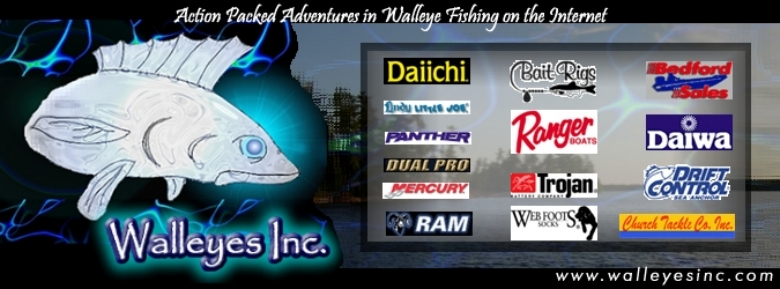Catching eating-size walleyes for the skillet
is fun. But, who wouldn’t want to see a 10-pound walleye
in the net?
Big fish get big because they’re wary. They’ve
got what it takes to avoid the hazards of the fish-eat-fish
world they live in, and they’re tough to fool into biting.
That’s what makes hoisting one into the boat something
special.
Two things are needed to have that dream come true. One is
attention to detail. You can’t have the fish of a lifetime
up to the surface only to have your line snap.
The other important ingredient is to fish where big fish live
and fish for them when they’re most vulnerable. Your
local river, reservoir or lake may hold a handful of big fish,
and you may be lucky enough to catch one of them. But, if
you want to increase your odds of a trophy, be prepared to
travel to trophy destinations at peak fishing times.
Now’s the time to start planning a trip in order to
make sure 2008 is the year your dream comes true. Here are
suggestions of where to go and when to go there for each season
of the calendar…
Lake Erie
It’s no secret the western basin of Lake Erie is the
walleye capital of the world during the spring. Hundreds of
thousands of big fish congregate near the Bass Islands to
spawn.
Best month is April, the month when Ted caught his personal
best walleye of 12.5 pounds and set a Professional Walleye
Trail record of 53.2 pounds for 5 fish!
The area is massive. Trolling with boards is the best way
to cover water and connect with a 10-pound-plus fish.
Cold water temperatures are the norm that time of year. The
water will range from 45 to 55 degrees F. What the temperature
gauge can help reveal is what trolling tactic is likely to
be most effective. The rule of thumb: crankbaits work best
under 50 degrees and spinner rigs and nightcrawlers work best
over 50 degrees.
For cranks, try Reef Runners, deep diving Rogues and Husky
Jerks. Be sure to try purple, blue prism and firetiger but
experiment with other colors, too. Let the fish tell you what
they want on any given day.
Use 10-pound Gamma High Performance Co-Polymer line, on line
counter reels. Ten-pound diameter is the basis on which the
dive curves in the book, “Precision Trolling”
is based. Often called the Troller’s Bible, this book
makes trolling at specific depths easy. Simply look at how
deep you want your lures to run and see how much line to let
out to get them there.
Productive depths are usually 10 to 20 feet down over 30 to
50 feet of water.
Go slow, 1.5 to 2 mph. Use planer boards to take baits away
from the boat. Troll in S-turns to cover more water and vary
the speed of the lures. As you turn, lures on the ‘inside’
will slow down, and those on the ‘outside’ will
speed up.
Use your GPS to mark locations where you connect with fish
and vary your trolling path. You’ll soon have an idea
of the exact location and size of the school. Humminbird’s
new side imaging technology marks suspended schools of fish
off to the side of the boat.
Trolling spinners requires even slower speeds of 1 to 1.5
mph. Use #4 to #6 blades in metallics for sunny days and clear
water and colored blades on cloudy days or when the water
is murky. The X-Change clevis makes changing them a snap.
Slightly off colored water, where you can just barely see
the bottom of your prop, is the best.
Bottom bouncers and snap weights should be used to take the
spinners down. Lindy’s new Shake-E-Blade bottom bouncers
provide a unique action/vibration in addition to attractive
flash to your spinners. Vary the weight of snap weights to
cover different parts of the water column.
Fort Peck
As spring turns to summer, shift your trophy search to America’s
western frontier and visit Fort Peck reservoir in July. Walleye
pro John Hook nailed a 12-pound-plus walleye to set a PWT
record there.
Bottom bouncers and spinner rigs using #3 and #4 blades are
the favored tactic, but with a twist. Instead of focusing
on deep water, walleyes tend to inhabit shallow water from
4 to 12 feet deep. Target big points of main creek arms where
walleyes will be on the tips or humps just off the tips.
Note wind direction and concentrate on the windy side of the
lake. This is where a little bit of a mudline lets walleyes
use their lateral lines to attack baitfish.
Follow the breaks as precisely as you can. Rather than planer
boards, use long rods to keep baits away from the boat as
much as possible and troll with your electric bow mount trolling
motor at 1 to 1.5 mph.
Use a run-and-gun approach. The more points you fish, the
more likely you’ll intercept the fish you’re after.

Pro fisherman Ted Takasaki hoists a monster walleye
against a rich October sky. From spring through winter,
follow Ted’s Trophy Walleye Planner to find big
fish on purpose |
Lake of the Woods
When July turns to August, try taking your trophy hunt
to Lake of the Woods out of Baudette, Minnesota. Lake
of the Woods probably produces more 10-pound fish than
any lake but Erie.
Target main-lake humps in Big Traverse Bay using Lindy
Rigs dressed with nightcrawlers and leeches.
The sinker can be the conventional Lindy sinker, a NO-SNAGG
sinker, or a Shake-E-Blade bottom bouncer. Three-eighths
of an ounce to one ounce should be heavy enough. Add a
bead for color.
A lot of the most productive humps don’t even appear
on any map. Watch your depthfinder as you travel from
one spot to another. If you see a hump in the productive
15 to 30 feet of water, look for marks near the bottom
with your sonar. |
Winnipeg River
Late fall is trophy time on the Winnipeg. Big fish become
vulnerable as they fatten up for winter. This was illustrated
very clearly in October of 2005, when Lindy pro staff member
Tom Backer caught a 13-pound walleye in Traverse Bay, which
is the basin where the Winnipeg River empties into massive
Lake Winnipeg.
The most productive tactic is to anchor and jig right below
the boat. The weight of your Max Gap jig depends on how close
you are to the mouth of the river, which pushes current well
out into the lake. Sometimes one-quarter ounce is enough.
Other times three-eighths of an ounce is needed. Within the
river, a one-ounce Fuzzy-E-Grub works best. Dress your jig
with a frozen emerald shiner. For short strikers, add a stinger
hook to your jig.
Two hooks per line are legal there. Add a Diachi Stand Out
Hook a foot above the jig and dress it with a frozen shiner.
Make sure you pinch the barbs back as it is a barbless province.
Look for turns in the river channel. The presence of rocks
makes that spot even more attractive. Productive depths are
10 to 14 feet. Anchor when you see fish on the sonar.
Bay of Quinte
When asked for suggestions on where to go for trophies through
the ice, Lindy pro staffer Dave Genz is quick to answer–
the Bay of Quinte in Ontario, Canada. Focus on Big Bay. There’s
a neckdown that creates fish-attracting current and shoals
in the bay itself. Keep fishing until you connect with perch.
The walleyes will be there. No perch? No walleye. Stay mobile.
Genz uses the new Rattl’n Flyer Spoon. Because it’s
a trophy you’re after, change the stock hook for a larger-sized
treble hook. Add a shiner or fathead.
Other destinations he recommends have been mentioned earlier
— Lake of the Woods and the Winnipeg River.
He also sends anglers to Saginaw Bay and the Saginaw River
in Michigan for ‘Shiver on the River,’ an ice-fishing
event held in January. As an indication of how many big fish
are there, cash awards are paid for the top 25 places. A 10-pound
walleye is usually needed to make it into the money.
A final word: 10-pound walleyes are rare no matter where you
fish. No one will fault someone for taking a trophy of a lifetime.
But, don’t make it a habit. Consider taking measurements,
several photos, and releasing the fish. Graphite reproductions
are easier to care for than skin mounts, they look just as
good, and you’ll win the praise of friends. They will
appreciate the fact you let the fish go for someone else to
catch and to keep its superior genes in the gene pool. That
way you and others can catch the same fish again later–
after it’s grown even more!
|

